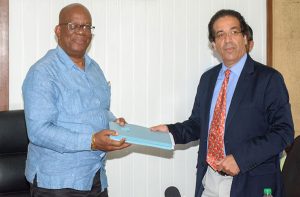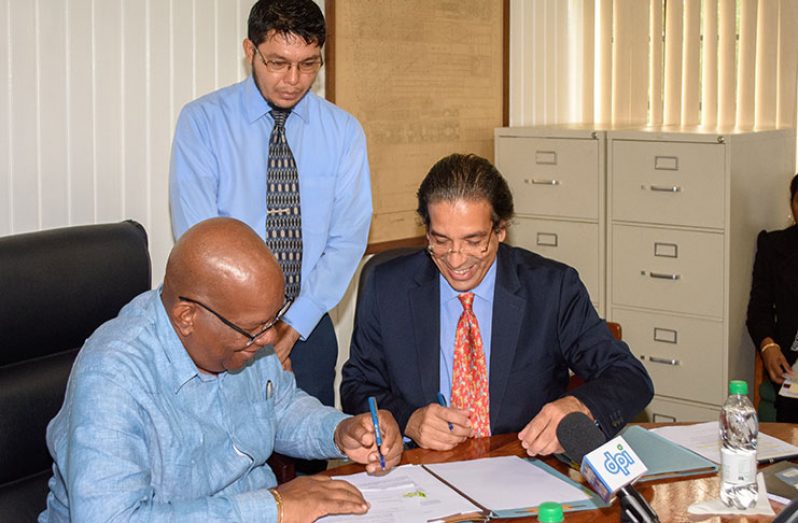…Govt, World Bank ink US$6M loan to reduce cash business
…expert pegs annual savings at $266M
GUYANA is moving closer to the digital money market with the signing of a US$6M loan agreement with the World Bank for the implementation of a National Payment system here, which financial experts say will help government save as much as $266M annually or 0.4 per cent of the country’s Gross Domestic Product (GDP) and move the country away from its heavy cash-based payment mechanism.
Top police sources said that this move will also reduce the temptation of bandits to go after citizens with large sums of cash. The agreement was one of two loans signed in the boardroom of the Ministry of Finance by subject Minister, Winston Jordan and the World Bank’s Senior Country Officer for Guyana, Suriname and Belize, Pierre Nadji. Also present at the signing ceremony were Minister within the Ministry of Finance, Jaipaul Sharma; Minister of Education, Nicolette Henry; Governor of the Bank of Guyana, Dr Gobind Ganga; Finance Secretary, Dr. Hector Butts; Vice Chancellor and Deputy Vice Chancellor of the University of Guyana, Professor Dr. Ivelaw Griffith and Dr Barbara Reynolds respectively; and acting General Manager, National Insurance Scheme, Holly Greeves.
The US$6M loan will allow for the improvement of the way money is handled here and caters to the ever-growing concern of security when doing large money transactions. “This loan is for developing an information system, the electronic transfer of cash to do cash business. They will look at the legal and regulatory framework, the policies and procedures on how to get to a kind of non-cash transaction arrangement for the handling of large amounts of cash; so it becomes an electronic transfer mechanism,” said the Director of Projects, Ministry of Finance, Tarachand Balgobin.
Balgobin explained that the National Payment System will initially be applied to government entities. He stressed that the project will facilitate the acquisition of hardware and software required by the Government to provide inter-bank clearing and settlement services for electronic payments, including hardware and software required for the real gross settlement systems and the central securities depository, for the Bank of Guyana, the Ministry of Finance, the Guyana Revenue Authority and the National Insurance Fund.

Additionally, the programme will provide connectivity among the aforementioned entities and private sector financial entities as well as support capacity building activities for the Bank of Guyana staff in technical areas of operation, and management of the payment system infrastructure. “It is expected that this will roll out into the private sector in time to come, once the platform is developed and managed by the Bank of Guyana,” he added.
Bank of Guyana Governor, Dr Gobind Ganga had said that government could save as much as $266M annually or 0.4 per cent of the country’s Gross Domestic Product (GDP) if it switches from paper-based payment mechanisms to electronic payments. Dr Ganga had noted that government is a major stakeholder as it is the single largest end-user of payment services. The Ministry of Finance, The National Insurance Scheme (NIS) and the Ministry of Social Protection all manage the largest of the outgoing payment programmes in the country, while the Guyana Revenue Authority (GRA) and NIS, both quasi-government agencies, manage the largest inflows. Other stakeholders include Commercial Banks, Money Transfer Agencies and the Business Community. “Excluding revenue collection, the programmes managed by the Finance Ministry, NIS and the Ministry of Social Protection account for an estimated 260,000 payments a month, a daily average of over 11,000 and over 3M annually.”
Over the next four years, the Governor had said the Bank will undertake payments system regulatory reform and infrastructural development to achieve several objectives, including but not limited to, the establishing of legal clarity and certainty to cover several areas such as electronic funds transfer, e-money and cheque truncation; enhancing efficiency of payment processing and reduce settlement times for both retail and large value transactions; strengthening risk management and mitigation across the National Payment System; expand accessibility of electronic payment across networks; attract higher rates electronic payment acceptance by vendors, merchants and other providers of goods and services; drive remittance costs down and enhance accessibility of remittance services; strengthen oversight framework and capacity; build stakeholder engagement and cooperation and support e-commerce. A 2015 payments cost study conducted by the World Bank’s Payment Systems Development Group (PSDG) shows that based on all indicators, once successfully implemented, the programme can lead to significant benefits in several areas.




.jpg)









